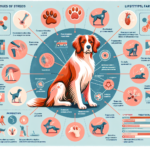Brittany Joint Pain: Causes, Symptoms, Prevention, and Treatment

Introduction
Overview of Brittany: The Brittany, often referred to as the Brittany Spaniel, is a versatile and energetic breed known for its exceptional hunting abilities and friendly disposition. Originating from the Brittany region of France, this breed has a rich history dating back to the 17th century. Brittanys are medium-sized dogs with a compact, athletic build, and they are highly valued for their agility, intelligence, and keen sense of smell. Their affectionate nature and adaptability make them excellent companions for active families and hunters alike.
General Health Concerns: Like all breeds, Brittanys are prone to certain health issues. Common concerns include hip dysplasia, epilepsy, and hypothyroidism. However, one of the most significant health challenges for Brittanys is joint pain, which can severely impact their quality of life and ability to perform activities they love.
Importance of Joint Health in Brittanys: Joint health is crucial for Brittanys due to their high energy levels and active lifestyle. Whether they are participating in hunting, agility competitions, or simply enjoying a vigorous play session, healthy joints are essential for their mobility and overall well-being. Ensuring good joint health can help prevent pain and discomfort, allowing Brittanys to lead active and fulfilling lives.
Breed-Specific Joint Pain Risks
Genetic Predisposition
Brittanys have a genetic predisposition to several joint-related issues, most notably hip dysplasia and elbow dysplasia. Hip dysplasia occurs when the hip joint does not fit properly into the hip socket, leading to pain and arthritis over time. Elbow dysplasia involves abnormal development of the elbow joint, which can also result in pain and lameness. These conditions are often hereditary, making it essential for breeders to screen for these issues and for owners to be aware of the risks.
Age-Related Risks
As Brittanys age, they become more susceptible to joint pain and arthritis. While joint issues can develop at any age, older Brittanys are particularly at risk. Owners should be vigilant about monitoring their dogs for signs of joint pain as they reach middle age, typically around 6-8 years old. Early detection and intervention can help manage symptoms and improve the dog’s quality of life.
Activity Level and Joint Stress
Brittanys are known for their high energy levels and love of physical activity. Whether they are running, jumping, or engaging in rigorous play, their joints are subjected to significant stress. While regular exercise is essential for their overall health, excessive or inappropriate activity can exacerbate joint issues. Owners should balance their Brittany’s need for exercise with the importance of protecting their joints.
Common Symptoms of Joint Pain in Brittanys
General Symptoms
- Limping: One of the most noticeable signs of joint pain is limping or favoring one leg over another.
- Stiffness: Dogs with joint pain may exhibit stiffness, especially after resting or sleeping.
- Reluctance to Move: A dog experiencing joint pain may be hesitant to engage in activities they once enjoyed, such as running or climbing stairs.
- Decreased Activity: Reduced activity levels and a general lack of enthusiasm for play can indicate joint discomfort.
- Behavioral Changes: Irritability, aggression, or withdrawal can be signs of pain and discomfort.
Breed-Specific Symptoms
In Brittanys, joint pain may manifest in specific ways due to their unique build and activity levels. Owners should watch for signs such as difficulty jumping into vehicles or onto furniture, a noticeable decrease in stamina during hunting or agility activities, and an unusual gait or posture. These breed-specific symptoms can provide early clues to joint issues.
When to Consult a Vet
If a Brittany exhibits any of the above symptoms, it is crucial to consult a veterinarian promptly. Early diagnosis and treatment can prevent further deterioration and improve the dog’s quality of life. Regular veterinary check-ups are also essential for monitoring joint health and catching issues early.
Preventive Measures for Joint Health
Exercise Recommendations
Regular exercise is vital for maintaining joint health in Brittanys, but it should be tailored to their needs. Low-impact activities such as swimming and controlled leash walks are excellent options. Avoid high-impact exercises like excessive running or jumping, which can strain the joints. Consistent, moderate exercise helps keep the joints flexible and muscles strong, supporting overall joint health.
Dietary Suggestions
A balanced diet rich in essential nutrients can support joint health. Foods containing glucosamine, chondroitin, and omega-3 fatty acids are particularly beneficial. These nutrients help maintain cartilage health and reduce inflammation. Owners may also consider joint supplements specifically formulated for dogs, but it is essential to consult a veterinarian before adding any supplements to the diet.
Weight Management
Maintaining a healthy weight is crucial for reducing joint stress. Excess weight puts additional pressure on the joints, exacerbating pain and discomfort. Owners should monitor their Brittany’s weight and adjust their diet and exercise routine as needed to prevent obesity. Regular weigh-ins and body condition assessments can help keep the dog at an optimal weight.
Early Screening and Monitoring
Early screening for joint issues can help catch problems before they become severe. Breeders should perform genetic testing for hip and elbow dysplasia, and owners should schedule regular veterinary check-ups that include joint assessments. Monitoring the dog’s movement and behavior can also provide early clues to joint pain, allowing for timely intervention.
Treatment Options for Joint Pain
Non-Surgical Treatments
Non-surgical treatments for joint pain in Brittanys include medications, physical therapy, and lifestyle adjustments. Anti-inflammatory drugs and pain relievers can help manage symptoms, while physical therapy can improve joint function and mobility. Lifestyle changes such as providing a comfortable bed, using ramps instead of stairs, and avoiding high-impact activities can also alleviate joint stress.
Surgical Options
In severe cases, surgical intervention may be necessary. Common surgeries for joint pain include hip replacement, arthroscopy, and joint fusion. These procedures can provide significant relief and improve the dog’s quality of life. However, surgery should be considered a last resort after exploring all non-surgical options.
Alternative Therapies
Alternative treatments such as acupuncture, hydrotherapy, and massage can also benefit Brittanys with joint pain. Acupuncture can help reduce pain and inflammation, while hydrotherapy provides low-impact exercise that supports joint health. Massage therapy can improve circulation and reduce muscle tension, providing relief from joint discomfort.
Lifestyle and Management Tips
Daily Care Routine
A consistent daily care routine can help manage joint pain in Brittanys. This routine might include gentle exercise, a balanced diet with joint-supporting nutrients, and regular veterinary check-ups. Providing a comfortable sleeping area and avoiding activities that strain the joints are also essential components of daily care.
Modifying the Home Environment
Making the home environment more comfortable for a dog with joint pain can significantly improve their quality of life. Consider using ramps instead of stairs, providing orthopedic beds, and ensuring that food and water bowls are at a comfortable height. These modifications can reduce joint stress and make daily activities easier for the dog.
Long-Term Management
Long-term management of joint pain involves ongoing monitoring and adjustments to the dog’s care routine. Regular veterinary visits, weight management, and appropriate exercise are crucial. Owners should also be prepared to make lifestyle changes as the dog’s condition evolves, ensuring that they remain comfortable and active despite joint pain.
FAQs About Brittanys and Joint Pain
What are the early signs of joint pain in Brittanys?
Early signs of joint pain in Brittanys include limping, stiffness, reluctance to move, decreased activity levels, and behavioral changes such as irritability or withdrawal.
Can joint pain in Brittanys be prevented?
While it may not be possible to prevent joint pain entirely, early screening, maintaining a healthy weight, providing appropriate exercise, and ensuring a balanced diet with joint-supporting nutrients can significantly reduce the risk.
Are there specific exercises that are better for Brittanys with joint pain?
Low-impact exercises such as swimming and controlled leash walks are ideal for Brittanys with joint pain. These activities help maintain joint flexibility and muscle strength without putting excessive stress on the joints.
What dietary supplements can help with joint health in Brittanys?
Supplements containing glucosamine, chondroitin, and omega-3 fatty acids can support joint health in Brittanys. However, it is essential to consult a veterinarian before adding any supplements to the dog’s diet.
When should I consider surgery for my Brittany’s joint pain?
Surgery should be considered a last resort after exploring all non-surgical options. If the dog’s quality of life is significantly impacted by joint pain and other treatments have not provided relief, surgical intervention may be necessary.
Conclusion
Joint pain is a significant concern for Brittanys, given their active lifestyle and genetic predisposition to joint issues. By understanding the causes, symptoms, preventive measures, and treatment options, owners can take proactive steps to ensure their Brittany’s joint health. Regular veterinary check-ups, appropriate exercise, a balanced diet, and weight management are crucial components of joint care. With proper management, Brittanys can continue to lead active and fulfilling lives despite joint pain.
Encourage readers to take preventive measures and consult their veterinarian regularly to ensure their dog’s joint health. Early intervention and consistent care can make a significant difference in the quality of life for Brittanys suffering from joint pain.




